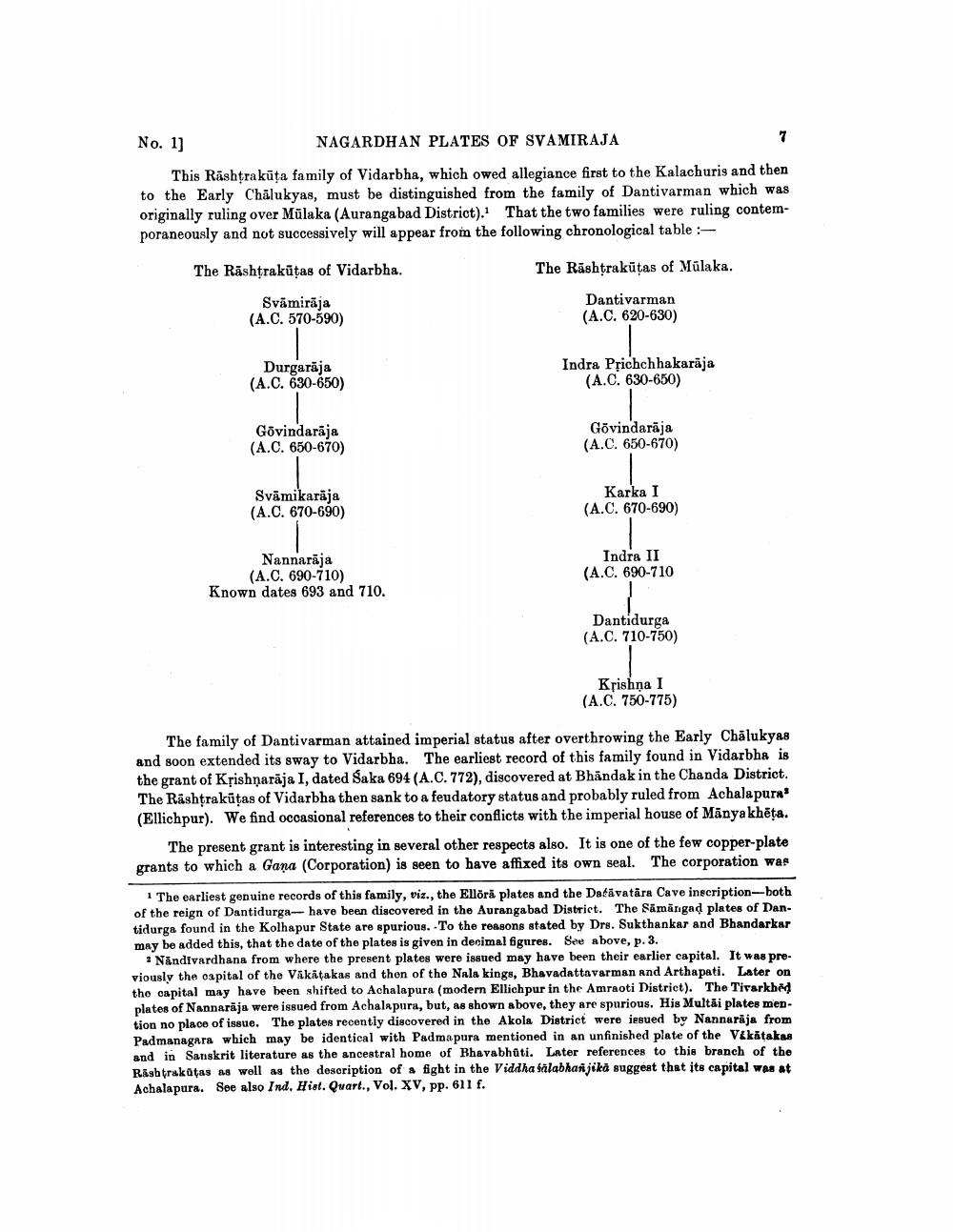________________
7
No. 1]
NAGARDHAN PLATES OF SVAMIRAJA
This Rashtrakuṭa family of Vidarbha, which owed allegiance first to the Kalachuris and then to the Early Chalukyas, must be distinguished from the family of Dantivarman which was originally ruling over Mülaka (Aurangabad District). That the two families were ruling contemporaneously and not successively will appear from the following chronological table :
The Rashtrakuṭas of Vidarbha.
The Rashtrakutas of Mülaka.
Svämirāja (A.C. 570-590)
Durgarāja (A.C. 630-650)
Govindaraja (A.C. 650-670)
Svämikarājs (A.C. 670-690)
Nannarāja (A.C. 690-710) Known dates 693 and 710.
Dantivarman (A.C. 620-630)
Indra Prichchhakarāja (A.C. 630-650)
Govindaraja (A.C. 650-670)
Karka I (A.C. 670-690)
Indra II
(A.C. 690-710
Dantidurga (A.C. 710-750)
Krishna I (A.C. 750-775)
The family of Dantivarman attained imperial status after overthrowing the Early Chalukyas and soon extended its sway to Vidarbha. The earliest record of this family found in Vidarbha is the grant of Krishnaraja I, dated Saka 694 (A.C. 772), discovered at Bhandak in the Chanda District. The Rashtrakutas of Vidarbha then sank to a feudatory status and probably ruled from Achalapura (Ellichpur). We find occasional references to their conflicts with the imperial house of Manyakhēta.
The present grant is interesting in several other respects also. It is one of the few copper-plate grants to which a Gana (Corporation) is seen to have affixed its own seal. The corporation was
1 The earliest genuine records of this family, viz., the Ellōră plates and the Datavatara Cave inscription--both of the reign of Dantidurga- have been discovered in the Aurangabad District. The Samangad plates of Dantidurga found in the Kolhapur State are spurious. To the reasons stated by Drs. Sukthankar and Bhandarkar may be added this, that the date of the plates is given in decimal figures. See above, p. 3.
Nandivardhana from where the present plates were issued may have been their earlier capital. It was previously the capital of the Väkäṭakas and then of the Nala kings, Bhavadattavarman and Arthapati. Later on the capital may have been shifted to Achalapura (modern Ellichpur in the Amraoti District). The Tivarkhed plates of Nannaraja were issued from Achalapura, but, as shown above, they are spurious. His Multai plates mention no place of issue. The plates recently discovered in the Akola District were issued by Nannaraja from Padmanagara which may be identical with Padmapura mentioned in an unfinished plate of the Vikātakas and in Sanskrit literature as the ancestral home of Bhavabhuti. Later references to this branch of the Rashtrakutas as well as the description of a fight in the Viddha falabhanjikā suggest that its capital was at Achalapura. See also Ind. Hist. Quart., Vol. XV, pp. 611 f.




